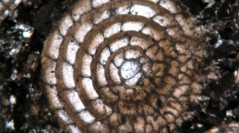

 Geodiversitas
43 (13) - Pages 377-389
Geodiversitas
43 (13) - Pages 377-389This study focuses on the Oligocene successions that contain predominantly siliciclastic, limestones with larger benthic foraminifera in the Burdur Basin of southwest Anatolia, Turkey. The Burdur-1 and Burdur-2 sections in the Oligocene deposits are described sedimentologically and were sampled for lithology, biostratigraphy, microfacies analysis and fossil content. Larger benthic foraminifera were mainly recovered from limestones in the upper part of the Burdur-2 section. Thin-section analysis of the larger benthic foraminiferal assemblage reveals that the upper part of the Burdur-2 section includes Nummulites fichteli Michelotti, 1841, Operculina complanata (Defrance, 1822), Nephrolepidina praemarginata (Douvillé, 1908), Eulepidina sp., Planorbulina sp., Amphistegina sp., and Asterigerina sp. This foraminiferal association represents the Shallow Benthic Foraminifera Zone 22 (SBZ 22) of Rupelian-early Chattian age. Sedimentological analysis in the Burdur-1 and Burdur-2 sections has revealed an association of massive-unorganized conglomerate, parallel-bedded sandstone, massive mudstone, graded-massive conglomerate, graded-massive sandstone, well-sorted organized conglomerate, well-sorted parallel-bedded sandstone and microfossil-bearing parallel-bedded limestone facies. Alluvial fan / river, fan-delta, beach and shallow shelf carbonate facies communities were identified by lateral and vertical correlation of facies. It is concluded that the large Burdur Fan developed in a graben basin that opened and was flooded by a branch of the Tethyan Ocean that invaded southwest Anatolia during the Oligocene.
Oligocene, Turkey, Burdur, larger foraminifera, micropalaeontology, sedimentology